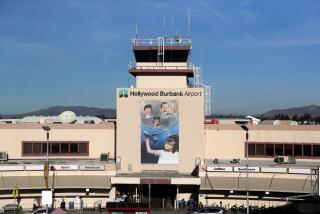FAA Chief’s Input Needed
- Share via
Federal Aviation Administrator Jane Garvey has until now kept an appropriate distance from the Great Burbank Airport War, instead urging warring parties to work out a local compromise.
But now that the compromise--or at least a draft compromise--is in place, the FAA chief’s involvement is both welcome and needed for the agreement to fly.
In August, the city of Burbank and the Burbank-Glendale-Pasadena Airport Authority signed a “framework for settlement” to replace the cramped, aging terminal building with a more modern facility in a safer location, one that isn’t so close to the east-west runway.
But the airport war is far from over. Since the agreement was signed, it’s been hard to keep track of the number of groups who oppose it, all for different reasons. Airline groups think it goes too far, homeowners groups, not far enough in controlling noise and the number of flights.
According to Burbank officials who met with her last week, Garvey agreed to “educate” the airline industry about the framework agreement and the trade-offs it requires.
Burbank officials agreed to redouble their efforts to make sure the agreement meets complicated federal laws on noise control and finances.
How about more guidance from Garvey and more persuasion from Burbank?
As head of the FAA, Garvey should clarify for Burbank officials whether the agreement meets FAA requirements. If there are areas where it does not--a plan to close the passenger concourses overnight, say, or a request to ban eastward takeoffs--why waste months fighting over them?
If they don’t meet FAA rules, it doesn’t mean the entire agreement must be scrapped. In some cases, of course, tactics may have to be changed. Garvey, for example, could play a role in persuading airlines to voluntarily accept the nighttime closure they now oppose. Burbank would have to persuade homeowners groups that such an agreement would stick.
As for continuing the current ban on easterly flights, couldn’t Garvey say now whether the FAA would honor such a request? The framework agreement calls for the Airport Authority to ask the FAA for a ban, but homeowner groups west of the airport contend that a ban would no longer be needed once the terminal is moved. The truth is, whether a ban is in place or not is unlikely to affect airport operations. Pilots and air traffic controllers, given prevailing winds, the Verdugo Mountains and Los Angeles International Airport airspace, prefer the safety margin afforded by other runways. So why insist on a ban--and give opponents something to rally around--as long as common sense and safety dictate takeoff and landing decisions?
Clearly, a war that’s gone on for so many years isn’t going to reach a swift end. But now that at least two of the many sides have heeded Garvey’s call to come up with an agreement, clear guidance--and strong persuasion--should follow.
More to Read
Inside the business of entertainment
The Wide Shot brings you news, analysis and insights on everything from streaming wars to production — and what it all means for the future.
You may occasionally receive promotional content from the Los Angeles Times.










